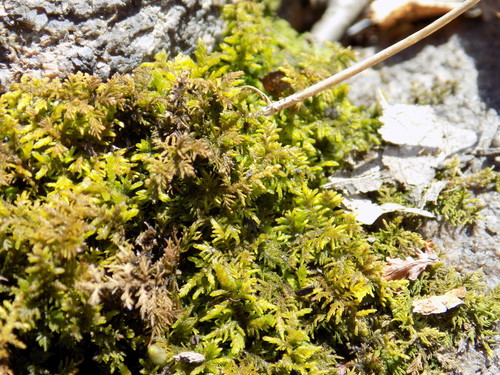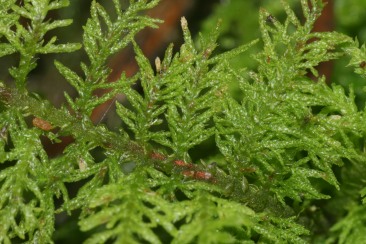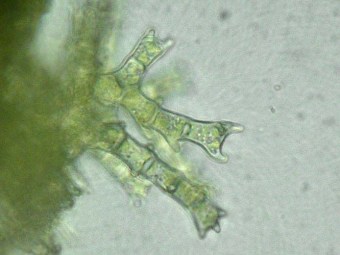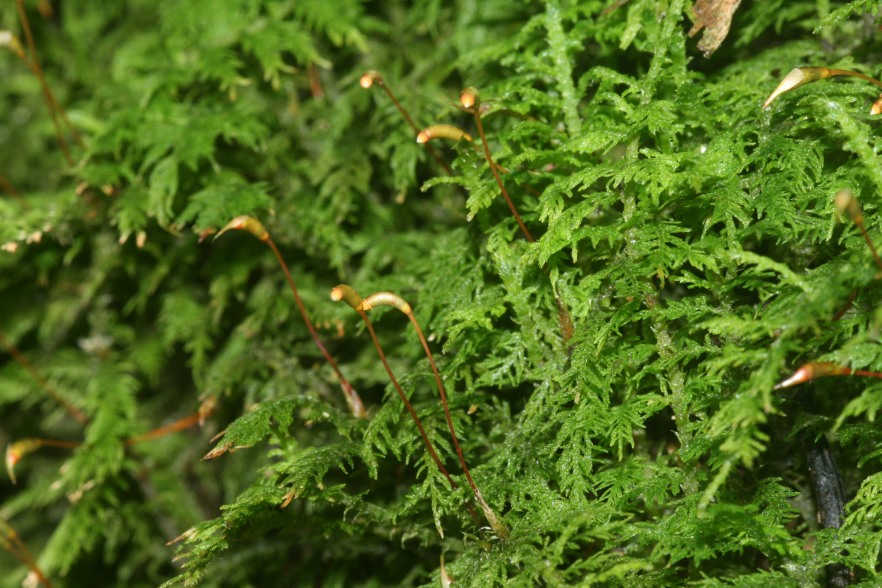Quick Facts
Family: Thuidiaceae
Genus: Thuidium
Also Known As: delicate thuidium moss, delicate fern moss
Found: Native to Northeastern North America, also found in parts of Mexico, Central/South America, and Europe
Life Cycle: Perennial
Category: Pleurocarpous bryophyte
Habitat: mostly found in mesophytic forests, but is also in dry-mesic forests as well. They grow on rocks, moist soils, humus, and fallen trees/branches. They prefer a slightly acidic soil with a pH around 5-6.
Common uses: Horticulture, gardening, and lawn care

Figure 1: Photo 1713542 by Cailin O’Connor Fitzpatrick licensed under CC BY 4.0
Appearance
This moss looks like a jumble of tiny ferns. Thuidium delicatulum has triangular broad leaves. The stem leaves are bigger than the branch leaves. The leaves have paraphyllia between them, or tiny thread-like branches. Figure 3 shows a close up of paraphyllia and clearly shows the branch like appearance.The leaves also have papillae on them which are small bumps within the cell walls of the plant. While the exact cause of papilla is not known, biologist agree that it probably has to do with water regulation within the organism. Thuidium delicatulum ranges in color from yellow-green to bright rich green. The stems can also sometimes have a reddish appearance. Thuidium delicatulum is capable of growing outward with rhizoids as well. Rhizoids aid in furthering the lateral growth of the moss by helping anchor it to its substrate and absorb minerals and water.
The sporophyte structure is connected to the rest of the moss by the seta, or stalk. At the top of the seta is the capsule. The capsule contains all the spores ready to be released. The capsule is composed of the lid, operculum, and the calyptra. The calyptra is a sheath composed of gametophytic tissue that surrounded the growing sporophyte and ripped off as it grew. The opening of the capsule is lined with peristome teeth, which are small triangular structures visible once the operculum falls away. Figure 4 shows the full sporophyte structure on the plant.Seta and capsule are clearly visible as well as the operculum.

Figure 2:Thuidium delicatulum by Hermann Schacher licensed under CC0

Figure 3: Microscopic view of paraphyllia, Untitled by polyploid.net
Reproduction
Mosses can be sorted into two reproductive categories: pleurocarpous and acrocarpous. Thuidium delicatulum is a pleurocarpous plant. Pleurocarpous plants reproduce in a “creeping” way by growing out from where they originate and rapidly. They grow laterally instead of upright and tuft like. Pleurocarpous plants develop the archeogonia (female sex organs) on short lateral branches, as opposed to on the tips in acrocarpous mosses. The antheridium (male sex organ) grow from mid stem, instead of straight up from the tips of the plant. Thuidium delicatulum is self fertilizing, but is not limited to.
Thuidium delicatulum can also reproduce with the help of humans or some other disturbance. When a section of the moss is removed from its substrate carefully it can be transplanted in another location and keep growing. This is called fragmentation and is a technique widely used by gardening enthusiasts. Fragmentation can also occur from different disturbances, such as, animal foot traffic.

Figure 4: Thuidium delicatulum by Hermann Schachner is licensed under CC0
Heavy Metals and Mosses
Mosses in general are very sensitive to contaminants found within their environments. Contaminants such as heavy metal ions can affect certain plant functions, such as photosynthesis, respiration, and protein synthesis to name a few (Shakya, Chettri, and Sawidis 2007). In a relatively recent study, Thuidium delicatulum specifically was studied for its uptake of heavy metals within a fairly polluted area. Heavy metal toxicity can cause decreased amounts of chlorophyll because the heavy metal ions can replace the magnesium in chlorophyll molecules and inhibit its production (Kupper, et al. 2002). Different mosses, including Thuidium delicatulum, were collected at a location near Kathmandu valley and then treated with different single metal solutions and then were analyzed for metal concentrations within the plant tissues as well as chlorophyll content. It was observed that Thuidium delicatulum had overall decreased levels of chlorophyll, which was expected with heavy metal toxicity. It was also noted that copper metal ions had the biggest affects on chlorophyll levels within Thuidium deicatulum which suggests that this metal has a huge inhibitory effect on chlorophyll production and protein synthesis.
References
Quick Facts
- “Delicate Thuidium Moss – Thuidium Delicatulum W. P. Schimper in B. S. G., 1852 – Classifications – Encyclopedia of Life.” Encyclopedia of Life. N.p., n.d. Web. 26 Oct. 2016. <http://eol.org/pages/860744/names>.
- “Results Detailed Report.” Results Detailed Report. NatureServe, 2 Feb. 2009. Web. 26 Oct. 2016. <http://explorer.natureserve.org/servlet/NatureServe?searchName=Thuidium%2Bdelicatulum>.
- “Plants Profile for Thuidium Delicatulum (delicate Thuidium Moss).” Plants Profile for Thuidium Delicatulum (delicate Thuidium Moss). United States Department of Agriculture, n.d. Web. 26 Oct. 2016. .” target=”_blank”><http://plants.usda.gov/core/profile?symbol=THDE10>.
Appearance
-
Glime, Janice. “CHAPTER 3-1 SEXUAL STRATEGIES.” Bryophyte Ecology. N.p.: n.p., n.d. N. pag. Web. .” target=”_blank”><http://www.bryoecol.mtu.edu/chapters/3Sexuality.pdf>.
- Glime, Janice. “CHAPTER 7-4 WATER RELATIONS: LEAF STRATEGIES.”Bryophyte Ecology. N.p.: n.p., n.d. N. pag. Bryophyte Ecology. 18 Sept. 2015. Web. 26 Oct. 2016. <http://www.bryoecol.mtu.edu/chapters/7-4WaterStratLeaf.pdf>
- Martin, Pamela J. “Viability Assessment Report For White Pine – Hemlock Habitat Association.” Viability Assessment Report For White Pine – Hemlock Habitat Association (n.d.): n. pag. U.S. Forest Service. United States Department of Agriculture, 15 July 2009.Web .” target=”_blank”><http://www.fs.usda.gov/Internet/FSE_DOCUMENTS/fsbdev3_032518.pdf>.
- Monthey, Roger, and Marilyn Mollicone. “The Biodiversity of a New England Woodlot Series: Mosses and Liverworts.” The Biodiversity of a New England Woodlot Series, Mosses and Liverworts (n.d.): n. pag.Northeastern Area. USDA Forest Service, Nov. 2000. Web. .” target=”_blank”><https://www.na.fs.fed.us/stewardship/pubs/mosses_liverworts/moss_and_liverworts.pdf>.
- Schafer, Karen L. Development of Papillae on Stem Leaves of Thuidium Delicatulum (Hedw.)BSG. (n.d.): n. pag. JSTOR. JSTOR, 4 Apr. 2012. Web. <http://harvardforest.fas.harvard.edu/sites/harvardforest.fas.harvard.edu/files/publications/pdfs/Ewers_AmJBotany_1983.pdf>.
Reproduction
- “How to Grow Moss.” Moss and Stone Gardens, www.mossandstonegardens.com/blog/how-to-grow-moss/.
- Hedenäs, Lars, and Michael Ignatov. “Homologies of Stem Structures in Pleurocarpous Mosses, Especially of Pseudoparaphyllia and Similar Structures.” Systematics Association Special Volumes Pleurocarpous Mosses, 2007, pp. 269–286., doi:10.1201/9781420005592.ch13.
- Ireland, Robert R. “Moss Pseudoparaphyllia.” The Bryologist, vol. 74, no. 3, 1971, pp. 312–330. http://www.jstor.org/stable/3241639.
- Martin, Annie. The Magical World of Moss Gardening. N.p.: n.p., n.d. Web. 26 Oct. 2016.
Heavy Metals and Mosses
- Shakya, K., M. Chettri, and T. Sawidis. “Impact Of Heavy Metals (Copper, Zinc, And Lead) On The Chlorophyll Content Of Some Mosses.” Archives Of Environmental Contamination & Toxicology54.3 (2008): 412-421. Environment Complete. Web. 30 Oct. 2016. <http://0-web.b.ebscohost.com.ksclib.keene.edu/ehost/detail/detail?vid=6&sid=f661840a-1aea-4d80-ae10-10ad2d1c0d4a%40sessionmgr103&hid=125&bdata=JnNpdGU9ZWhvc3QtbGl2ZSZzY29wZT1zaXRl#AN=31186599&db=eih>
- Küpper, Hendrik, et al. “Heavy Metal-Induced Inhibition Of Photosynthesis: Targets Of In Vivo Heavy Metal Chlorophyll Formation1.” Journal Of Phycology 38.3 (2002): 429-441. Academic Search Complete. Web. 9 Nov. 2016. <http://0-web.b.ebscohost.com.ksclib.keene.edu/ehost/pdfviewer/pdfviewer?sid=936d9df5-6f0a-4a00-b725-eff88af5db31%40sessionmgr102&vid=1&hid=125>